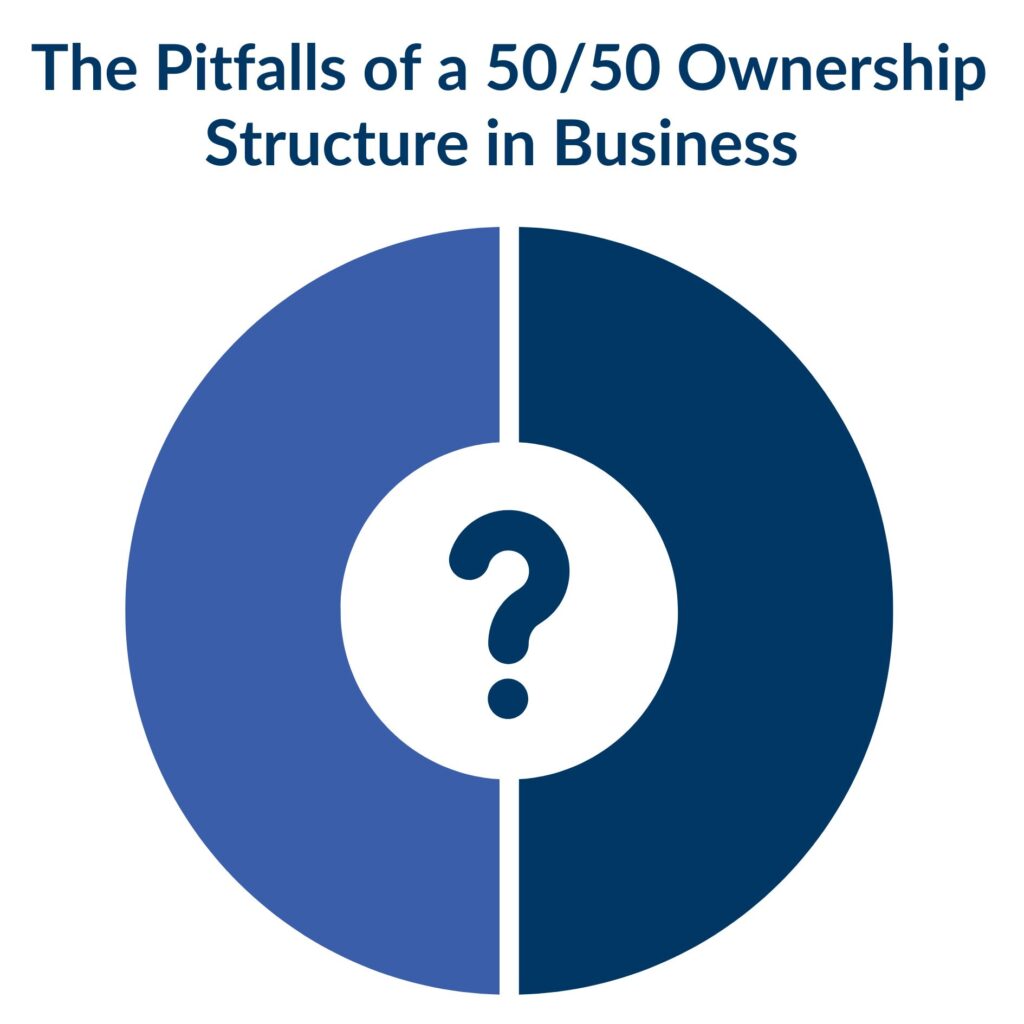We recently worked with a client navigating a complex situation after their father passed away, leaving his business equally divided between his two children. One sibling was actively involved in the company’s operations, while the other had no direct involvement. The sibling working in the business wanted to buy out their sibling’s 50% ownership interest but faced a challenge: their sibling didn’t fully understand why owning 50% of a business doesn’t necessarily equate to owning half its total value.

This scenario underscores an important issue in business ownership and valuation. A 50% stake often comes with limitations that differ significantly from full ownership, particularly in areas like control, decision-making, and marketability. Minority ownership stakes, even at 50%, usually lack the authority to make unilateral decisions and may face discounts in market value due to reduced influence and challenges in finding buyers.
In this article, we’ll break down these valuation dynamics, explain why a 50% ownership interest isn’t the same as full ownership, and provide insights into structuring ownership to avoid common challenges. Understanding these nuances is essential for clear communication, fair negotiations, and long-term business success.
Why 50/50 Ownership Structures Sound Ideal
A 50/50 setup is often appealing because it creates a sense of partnership and collaboration. Neither party has more power than the other, and both share equally in the rewards and risks. For many, this structure symbolizes equality and trust between co-founders.
However, this "perfectly balanced structure" often hides deeper challenges that can jeopardize the business’s operations, valuation, and growth potential.
Key Pitfalls of a 50/50 Ownership Structure
1. Lack of Unilateral Decision-Making Power
A 50% equity interest gives no one party full control over business decisions. While this may sound fair, it often results in deadlock. Imagine critical business decisions—hiring a CEO, approving budgets, or deciding whether to accept investor funding—being stalled because neither partner can agree. Without a mechanism to resolve disputes, this stalemate can cripple your business’s operations.
2. Risk of Deadlock
Deadlocks are a common issue with 50/50 ownership, where neither partner has the authority to move forward unilaterally. This can lead to critical delays in decision-making or disagreements escalating into conflicts. Not only does this harm the day-to-day functioning of the business, but it can also erode trust between partners, potentially leading to the dissolution of the company.
3. Valuation Implications of a 50% Stake
From a business valuation perspective, a 50% share does not carry the same value as a controlling block of equity (51% or more). A 50% interest lacks the ability to influence decisions or dictate the company’s strategic direction. Business appraisers factor this in by applying a discount for lack of control and marketability to minority or shared blocks of equity.
A controlling equity interest (51%+) is considered more valuable because it grants the owner the authority to make key decisions, such as altering the capital structure or selling the company. A minority or shared interest, even at 50%, lacks these powers, resulting in a lower valuation compared to a pro-rata calculation of the business’s total worth.
4. Challenges in Resolving Disputes
Without a clear legal framework outlining how disputes are handled, disagreements can escalate into damaging conflicts. Without mechanisms like dispute resolution clauses or casting votes, 50/50 partnerships leave businesses vulnerable to power struggles when disagreements arise.
5. Dilution of Strategic Roles
If roles and responsibilities aren’t clearly defined at the start, partners may step on each other’s toes, duplicating efforts or leaving gaps in responsibilities. The lack of a clearly delineated hierarchy can lead to inefficiency and confusion, especially as the company grows.
Tips to Avoid the Pitfalls of a 50/50 Ownership Structure
1. Clearly Define Roles and Responsibilities
At the outset, it’s critical to establish who is in charge of what. Create detailed job descriptions for each partner to avoid overlap and ensure all areas of the business are effectively managed.
2. Draft Comprehensive Dispute Resolution Mechanisms
Legal agreements should explicitly outline how disputes will be handled—whether through mediation, arbitration, or a casting vote by a neutral third party. These mechanisms can save your business when founders are unable to agree on a pivotal decision.
3. Understand the Valuation Implications
For businesses considering a 50/50 partnership, it’s essential to understand that the valuation of a 50% stake is not equal to half the company’s total value. Discounts for lack of control and marketability will likely be applied if you attempt to sell your equity interest, limiting its financial return.
4. Consider Alternative Ownership Structures
One way to avoid the challenges of a 50/50 ownership structure is by assigning a 51/49 split. This provides a controlling interest to one founder, ensuring clear decision-making authority while still maintaining a collaborative spirit. Additionally, you can incorporate specific provisions in your agreement to check the power of the majority owner, balancing control with fairness.
5. Seek Legal Counsel
Engage experienced legal professionals to help draft robust agreements that address potential conflicts and establish operational roles. A well-crafted partnership agreement can preemptively resolve issues that typically arise in 50/50 structures.
Control vs. Equity Value: Why It Matters
When considering ownership structures, it’s important to understand that not all equity stakes are valued equally. A 51% controlling interest is much more valuable than a 49% minority interest because the former allows for unilateral decision-making. Similarly, even a 2% interest can become pivotal in certain scenarios, as it might give a buyer controlling power in previously deadlocked situations.
These distinctions are crucial during company valuation. Controlling owners have the ability to adjust executive compensation, pursue business expansion, or even sell the enterprise. Minority owners or shared-equity holders, however, lack these capabilities, reducing the financial and strategic value of their stake.
Final Thoughts
In the end, we were able to help our client articulate to our client these key differences, which put them at ease when faced with the challenge of making an offer to purchase their sibling's shares. By breaking down the complexities of valuation, our client gained a clearer understanding of the differences between owning a controlling interest in a company and a non-controlling interest in a company. This approach fostered mutual trust and laid the foundation for a smoother transition, ensuring the business's continued success and preserving familial relationships.
While 50/50 ownership may feel fair and balanced, the structure is rife with pitfalls that can hinder the growth, valuation, and operational stability of your business. Deadlocks are a common issue; disagreements without resolution mechanisms can stall decision-making, damage relationships, and threaten your company’s future.
Set your business up for long-term success by taking a strategic approach from the start. Explore alternative structures, consult legal and valuation experts, and safeguard your partnership with well-drafted agreements.
Need expert guidance? Consult with a legal or valuation professional to assess the best approach for your business. A well-informed strategy today can save you from significant headaches tomorrow. Schedule a complimentary call with us today.

